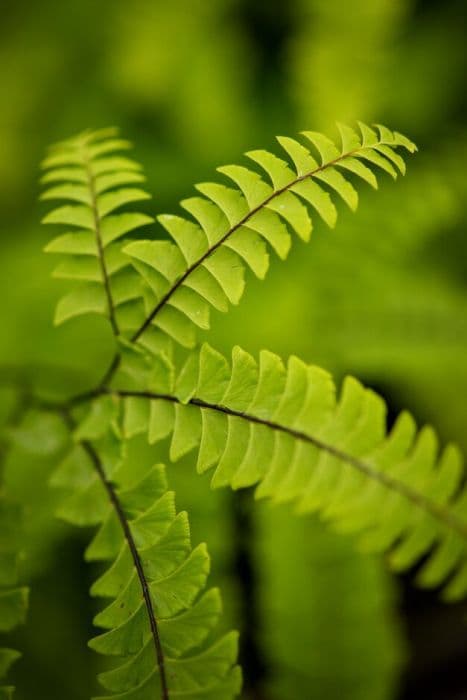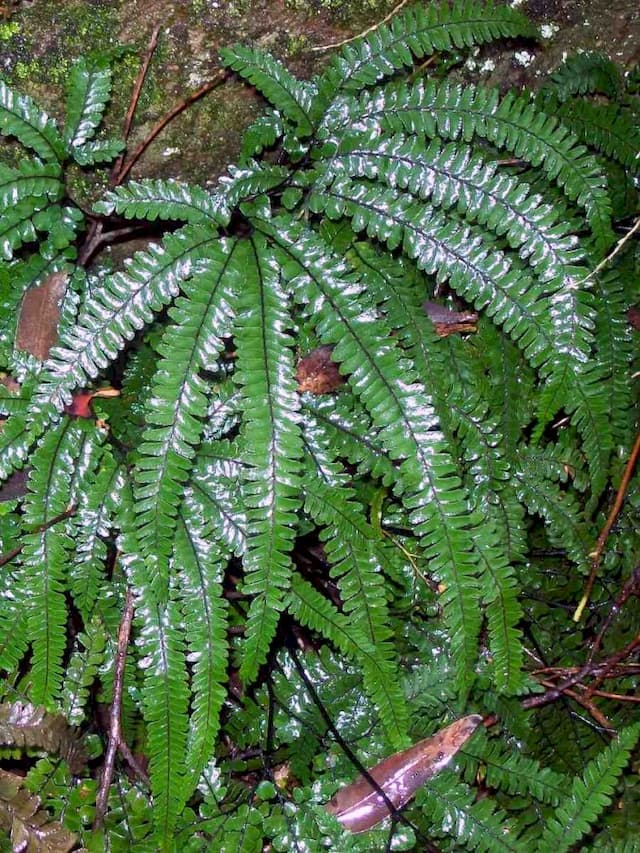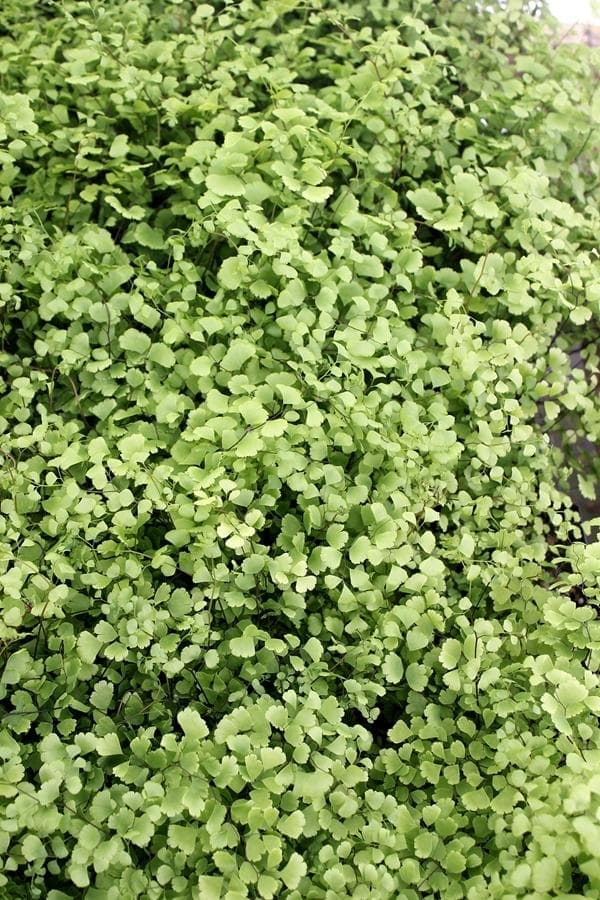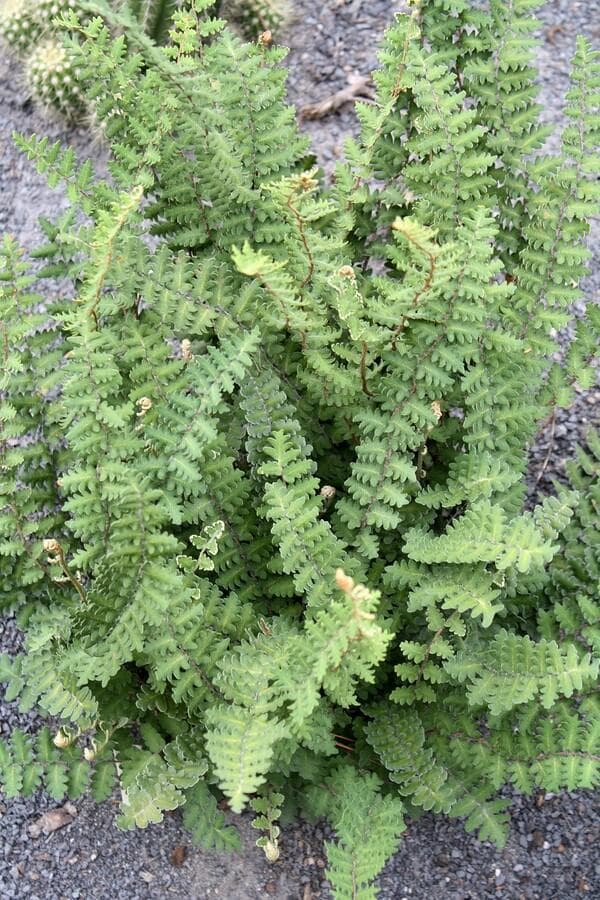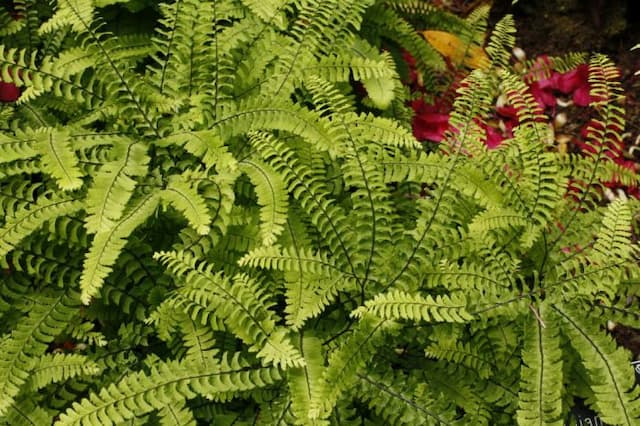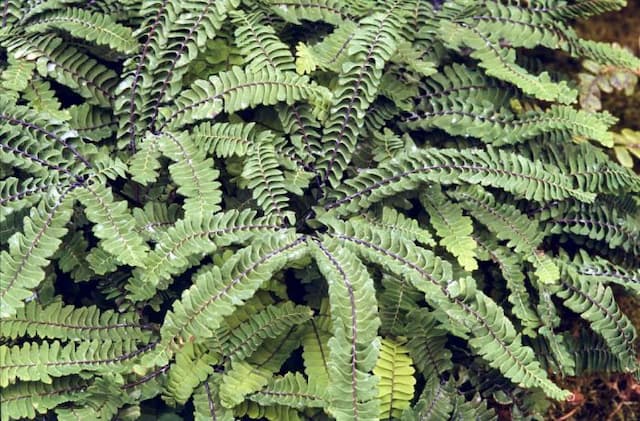Himalayan Maidenhair Fern Adiantum venustum

ABOUT
Adiantum venustum, commonly known as Himalayan maidenhair fern, is an elegant and delicate fern species. This plant is known for its attractive, fan-shaped fronds which have a graceful, arching habit. The leaflets, also known as pinnae, are small, light green, and triangular, and they are arranged alternately along the thin, black or dark brown stems that resemble wiry stalks. When the fronds first emerge in spring, they can have a bronzy-pink tint, which eventually turns into a lush, bright green as they mature. They are smooth to the touch and appear somewhat glossy, contributing to the plant's overall vibrant look. Himalayan maidenhair fern has a creeping rhizome from which the fronds grow in a lush, clustered manner, presenting a dense mat of foliage that can appear as a carpet of greenery. The overall texture of the plant is feathery and light, which sways gently with the breeze and adds a sense of softness to any garden environment or cultivated space. Despite the fragile appearance of its fronds, Himalayan maidenhair fern is quite resilient and can tolerate various growing conditions when its basic needs are met.
About this plant
 Names
NamesFamily
Pteridaceae
Synonyms
Himalayan Maidenhair Fern, Evergreen Maidenhair Fern, Indian Maidenhair Fern
Common names
Adiantum capillus-veneris var. venustum, Adiantum soboliferum, Adiantum trapeziforme var. soboliferum.
 Characteristics
CharacteristicsLife cycle
Perennials
Foliage type
Evergreen
Color of leaves
Green
Height
1 foot (30 cm)
Spread
1-2 feet (30-60 cm)
Plant type
Fern
Hardiness zones
5
Native area
Asia
Benefits
 General Benefits
General Benefits- Aesthetic Appeal: As a decorative plant, Himalayan maidenhair fern (Adiantum venustum) adds lush greenery and delicate, finely textured fronds to gardens or indoor spaces.
- Shade Tolerant: The plant thrives in shaded areas where other plants may struggle, making it ideal for filling under-tree spaces or north-facing gardens.
- Ground Cover: Its creeping growth habit allows it to spread evenly, creating an attractive ground cover that can help prevent soil erosion.
- Low Maintenance: Himalayan maidenhair fern requires minimal attention once established, making it convenient for busy gardeners.
- Humidity Lover: It is an excellent choice for adding greenery to damp or humid areas such as bathrooms or kitchens.
- Companion Planting: This fern can be used effectively in mixed plantings to provide contrast with other foliage types or flowers.
- Cold Hardy: Adiantum venustum is relatively cold-resistant compared to other fern species, allowing it to survive in cooler climates.
- Wildlife Friendly: The dense foliage offers shelter to various insects and small wildlife, promoting biodiversity in the garden.
 Medical Properties
Medical Properties- Expectorant: Adiantum venustum is thought to help expel phlegm from the respiratory tract.
- Diuretic: It may increase urine production, thereby aiding in the removal of excess water from the body.
- Demulcent: The plant has soothing properties, which might be beneficial for relieving irritation of mucous membranes.
- Antitussive: It is believed to have cough-suppressing properties.
 Air-purifying Qualities
Air-purifying QualitiesThis plant is not specifically known for air purifying qualities.
 Other Uses
Other Uses- Adiantum venustum, commonly known as Himalayan maidenhair fern, can be used to create subtle visual textures in terrariums or miniature garden landscapes.
- Himalayan maidenhair fern may be used in floral arrangements for its delicate foliage that adds a feathery contrast to more robust plants.
- This plant's trailing nature makes it excellent for hanging baskets, providing a cascading green effect in home decor.
- The fine leaves of the Himalayan maidenhair fern can be used in art projects that involve plant pressing, due to their intricate vein patterns.
- In shaded water gardens or ponds, Himalayan maidenhair fern can be a suitable companion to aquatic plants, providing a soft backdrop.
- Hobbyists can use the fronds of Himalayan maidenhair fern for creating miniature or fairy garden scenes.
- This fern can be used in educational settings to demonstrate the diversity of fern species and the unique structure of fern leaves.
- Crafters may utilize the elegant fronds of the Himalayan maidenhair fern to create naturalistic themes in scrapbooking or paper crafting.
- Gardeners may use this fern as a living mulch under larger plants or trees, helping to retain soil moisture and suppress weeds.
- Himalayan maidenhair fern can be grown as part of a green roof system, contributing to a diverse plant community on rooftops.
Interesting Facts
 Feng Shui
Feng ShuiThe Himalayan maidenhair fern is not used in Feng Shui practice.
 Zodiac Sign Compitability
Zodiac Sign CompitabilityThe Himalayan maidenhair fern is not used in astrology practice.
 Plant Symbolism
Plant Symbolism- Delicacy: The Adiantum venustum, commonly known as Himalayan maidenhair fern, has a delicate and elegant appearance which often represents fragility and a gentle spirit in the language of plants.
- Discretion: With its fine, light foliage that seems to blend into its surroundings, the Himalayan maidenhair fern symbolizes discretion and the ability to quietly go unnoticed.
- New Beginnings: Ferns in general, including the Himalayan maidenhair fern, are often seen as symbols of new growth, hope, and renewal thanks to their ability to thrive in challenging conditions and their role in natural succession after events like wildfires.
- Secret Bond: Given the plant's unassuming beauty and how it can be overlooked in the wild, it can symbolize a secret bond or love that is cherished but not always seen by others.
- Shelter: As the Himalayan maidenhair fern can often be found in sheltered spots in its native habitat, it has come to symbolize shelter and the provision of a safe haven.
 Water
WaterHimalayan maidenhair fern (Adiantum venustum) prefers consistently moist soil but not waterlogged conditions. Water the plant thoroughly, allowing the water to soak through to the roots, and then let the top inch of soil dry out before watering again. Typically, this means watering once a week, but this can vary depending on environmental conditions such as temperature and humidity. When watering, avoid splashing water on the delicate fronds as this can promote fungal diseases. Each watering should provide enough water to moisten the soil throughout the pot, which may amount to about 16-32 ounces for a standard-sized indoor pot.
 Light
LightThe ideal lighting for Himalayan maidenhair fern is bright, indirect light. It should be placed in a spot that receives dappled sunlight or where the direct sun is filtered through curtains or blinds. Avoid exposing the fern to prolonged direct sunlight as this can scorch the delicate fronds and lead to browning.
 Temperature
TemperatureHimalayan maidenhair fern thrives best at temperatures between 65 to 75 degrees Fahrenheit. It can tolerate a minimum temperature of 60 degrees Fahrenheit and should not be exposed to temperatures below 55 degrees Fahrenheit as this can cause harm. Ensure the fern is kept away from cold drafts and heating vents to maintain a consistent temperature.
 Pruning
PruningPruning Himalayan maidenhair fern is usually done to remove any brown or damaged fronds to maintain its aesthetic appearance. It's best to prune in the spring, as this is when the plant is entering a period of active growth. Carefully snip the unwanted fronds at the base using sharp, sterilized scissors. Pruning also helps promote denser growth and allows new fronds to flourish.
 Cleaning
CleaningAs needed
 Soil
SoilHimalayan maidenhair fern thrives in a soil mix that is rich in organic matter with good drainage; a mixture of loam, peat, and sand works well. It prefers a slightly acidic to neutral pH of about 6.0 to 7.0.
 Repotting
RepottingHimalayan maidenhair fern should be repotted every 2-3 years to refresh the soil and accommodate the plant's growth.
 Humidity & Misting
Humidity & MistingThe Himalayan maidenhair fern requires high humidity levels, ideally around 60% or higher, to thrive.
 Suitable locations
Suitable locationsIndoor
Place in bright, indirect light, and ensure high humidity.
Outdoor
Choose a shaded spot, protect from strong winds.
Hardiness zone
5-8 USDA
 Life cycle
Life cycleAdiantum venustum, commonly known as Himalayan maidenhair fern, begins its life cycle when spores released from mature ferns germinate in moist, shaded soil to form a heart-shaped gametophyte, also called a prothallus. The gametophyte houses both male and female reproductive organs, which, after reaching maturity, produce sperm and eggs. Fertilization occurs when water allows the sperm to swim to the eggs, resulting in a zygote that will grow into a new sporophyte fern. The young sporophyte initially shares resources with the gametophyte before becoming an independent plant. As the sporophyte matures, it develops fronds that unfurl and photosynthesize to fuel growth. Once the fern reaches maturity, it produces clusters of spores beneath the fronds, completing the life cycle and beginning the process anew.
 Propogation
PropogationPropogation time
Spring to Summer
The Himalayan maidenhair fern, known botanically as Adiantum venustum, is propagated most effectively through division. This method should be performed in the spring when the plant emerges from dormancy and begins to show new growth. To propagate by division, a gardener would carefully lift the fern from the ground or its container, ensuring to minimize root disturbance. They would then gently tease apart clumps of fronds and roots, making sure that each new section has a good amount of roots attached. These divisions are then immediately planted in a well-draining, humus-rich soil mix and kept moist until they establish in their new setting. This technique allows the quick and efficient multiplication of the fern while maintaining the desirable characteristics of the original plant.
